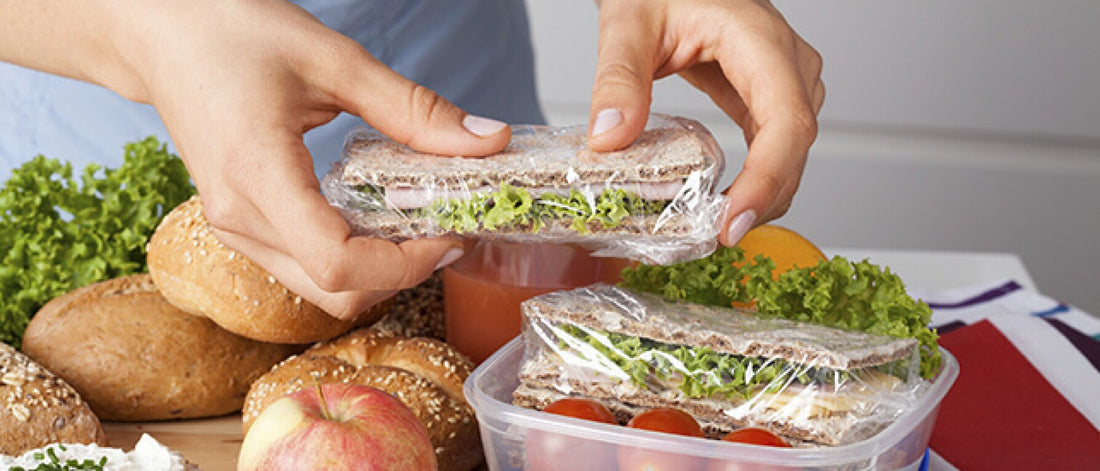As a health-conscious parent, it’s easy to walk through a school cafeteria and cringe at the choices available to kids. From Lunchable, artificially-made, peanut butter and jelly sandwiches to cups of fruit floating in water, it may seem that the healthy habits you’re teaching at home cannot be brought to school. Rest assured, you can help your school-aged children keep healthy while enjoying their lunch. Here’s how …
The idea here is balance. For example, you might want to give your child the option of four categories: dairy, breads or another carbohydrate, a protein item, and fruit or a vegetable. They must pick at least one from each category to put in the lunch. As long as you’re monitoring the quality of food and he is filling each category, let them pick. One thing you must keep in mind is that they’re the one eating it. Try not to get caught up in the fact that they’re eating the same lunch day after day.
Another reason to pay attention to portions is time. I’ve spent an adequate amount of time in school cafeterias and kids generally have about 20 minutes or less to eat their lunches. Couple that with little hands that have difficulty opening packages and the time to get straws or napkins, it doesn’t leave a lot of time to eat. After getting frustrated with my little one for not finishing his lunch consistently he finally said to me, “Mom, I just didn’t have time to finish.” Once I figured this out, I put less in his lunch and smaller portions of each item.
Make Your Child a Part of the Process
One way ensure sure your child will eat a healthy lunch is to have them help. I have a list of foods I will accept in the home and if we’re out, it’s Whole Foods Market or another organic store. This way, there is no question of getting Oreos or Cheetos in the lunchbox. When choosing foods, explain to your child the importance of balancing protein with carbohydrates and a fruit or vegetable.The idea here is balance. For example, you might want to give your child the option of four categories: dairy, breads or another carbohydrate, a protein item, and fruit or a vegetable. They must pick at least one from each category to put in the lunch. As long as you’re monitoring the quality of food and he is filling each category, let them pick. One thing you must keep in mind is that they’re the one eating it. Try not to get caught up in the fact that they’re eating the same lunch day after day.
Pay Attention to Portion Sizes
Adults are not the only ones who need to pay attention to portion sizes. Many children are good at monitoring their hunger levels, but others are not able to control satiety levels. With childhood obesity on the rise, it’s something all parents should monitor. If you are purchasing prepackaged snacks and beverages, pay attention to the overall calorie count. According to the National Institute of Health, a moderately active child should get between 1,400 and 1,800 calories per day. However, we must remember that kids are sitting for a big portion of the day.Another reason to pay attention to portions is time. I’ve spent an adequate amount of time in school cafeterias and kids generally have about 20 minutes or less to eat their lunches. Couple that with little hands that have difficulty opening packages and the time to get straws or napkins, it doesn’t leave a lot of time to eat. After getting frustrated with my little one for not finishing his lunch consistently he finally said to me, “Mom, I just didn’t have time to finish.” Once I figured this out, I put less in his lunch and smaller portions of each item.
Healthy Eating Starts at Home
If you allow chips at home, don’t be surprised if your child wants to bring them to school. Your child’s school lunch should be an extension of what they’re already eating at home. My kids are among the pickiest eaters out there but I’m firm on quality and the wholesome nature of food. Your child may fight you on whole-wheat organic bread in the beginning, but if you only have that bread in the house, they will have to eventually concede or give up eating bread. If you want your child to eat more vegetables, eat vegetables. Children learn by example rather than by preaching.Examples of Winning School Lunches
Here are a few ideas for kid-friendly lunches, which are also healthy. For drinks in your child’s bagged lunch, try organic milk or water.- Small whole-wheat tortilla wrap with nut butter and honey, a small Greek yogurt, a few grapes.
- Whole grain mini bagel with hummus, lettuce, tomato, and feta cheese, a few celery or carrot sticks, a small bag of Annie’s Organic Cheddar Bunnies.
- Whole-grain sandwich cut outs (with cookie cutter shapes) filled with organic turkey breast and cheese, fresh apples slices, edamame, and organic fig newtons.
- “Breakfast for Lunch” lunch: Greek yogurt plain or vanilla flavored, with a small bag of organic granola cereal, fresh blueberries, banana slices, and chopped almonds or pecans to put on top. A hard-boiled egg and a mini whole grain bagel on the side.






















